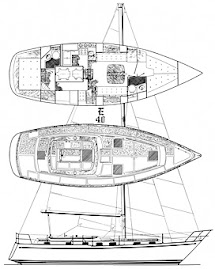
 It had been about 20 years since Pat had been to the Dry Tortugas and about 15 years since Bill had been there. Man, how things have changed! That old laid back park with a staff of 5 or 6 people is long gone. Dry Tortugas National Park is now surrounded by a Marine Research Natural Area (with all it’s rules and regulations). The first day we were there we dingied over to the fort and sat out on the dock while 5 law enforcement officers (park rangers, marine sanctuary police and, we think, Florida Marine Patrol, all dressed in full assault gear including guns, handcuffs, batons, handcuffs, tazers, boots, etc.) harassed 4 guys in their brand new 41 ft. open sport fisherman. Apparently, the 4 guys had been scuba diving and were on their way back to the fort when one of the patrol boats had attempted to stop them (because they thought they might be fishing). No one in the sportfish noticed the patrol boat or its blue lights, and the patrol boat was unable to catch the sportfish, which is capable of speeds up to 65 mph. Once they docked back at the fort, they were boarded and inspected by all three agencies. They had all the approprate gear and easily passed all inspections. After being inspected and talked down to a for quite a while, they were allowed to return to Key West. In the old days, when there were only 5 or 6 park service staff living on the island, only a small part of the historic fort was dedicated to park housing and maintenance. Now it seems that about half the fort is used for park housing and maintenance with only the remaining half open to the general public. While we were there we were never approached by a park service interpreter (that’s the smiling park person who usually tells you all the history, guides tours or gives campfire talks), however, we were required, by a park ranger, to fill out a permit request form and given pamphlets with all the new rules and regulations. In spite of all these changes, the Dry Tortugas and Fort Jefferson is still a beautiful place to visit.
It had been about 20 years since Pat had been to the Dry Tortugas and about 15 years since Bill had been there. Man, how things have changed! That old laid back park with a staff of 5 or 6 people is long gone. Dry Tortugas National Park is now surrounded by a Marine Research Natural Area (with all it’s rules and regulations). The first day we were there we dingied over to the fort and sat out on the dock while 5 law enforcement officers (park rangers, marine sanctuary police and, we think, Florida Marine Patrol, all dressed in full assault gear including guns, handcuffs, batons, handcuffs, tazers, boots, etc.) harassed 4 guys in their brand new 41 ft. open sport fisherman. Apparently, the 4 guys had been scuba diving and were on their way back to the fort when one of the patrol boats had attempted to stop them (because they thought they might be fishing). No one in the sportfish noticed the patrol boat or its blue lights, and the patrol boat was unable to catch the sportfish, which is capable of speeds up to 65 mph. Once they docked back at the fort, they were boarded and inspected by all three agencies. They had all the approprate gear and easily passed all inspections. After being inspected and talked down to a for quite a while, they were allowed to return to Key West. In the old days, when there were only 5 or 6 park service staff living on the island, only a small part of the historic fort was dedicated to park housing and maintenance. Now it seems that about half the fort is used for park housing and maintenance with only the remaining half open to the general public. While we were there we were never approached by a park service interpreter (that’s the smiling park person who usually tells you all the history, guides tours or gives campfire talks), however, we were required, by a park ranger, to fill out a permit request form and given pamphlets with all the new rules and regulations. In spite of all these changes, the Dry Tortugas and Fort Jefferson is still a beautiful place to visit. By Tuesday we were ready to leave, and the weather looked like it would cooperate, so we put the dingy up on davits, tied everything down and prepared to leave early Wednesday morning. After one last check of the weather, we left the Dry Tortugas about 7:00am Wednesday morning in route to Isla Mujeres, Mexico. The winds were expected to be around 10 kts from the east and south. We got winds from 5 to 14 kts mostly out of the southeast.. The trip was pretty uneventful except once when Otis (our autopilot) decided to go on strike. We were in the gulf stream when it decided to steer us first go one way then the other. Bill finally decided that the flux gate compass was sticking, so while Pat steered the boat, he removed the compass from the bulk head under the aft cabin bunk, made sure all wires were connected, shook it a few times, then wedged it between the mattress and a bulkhead. After that, the autopilot has worked better than it ever has in the past. We saw very few boats or ships until we reached the Yucatan straights, then there were lots of ships to watch out for.


 We arrived at Isla Mujeres about 4:00pm Friday, set the anchor and got a good night’s sleep. On Saturday morning, we took a slip in Marina Paraiso, then went into town to clear customs etc. Since it was Saturday, the doctor was not at the clinic, and no one else there spoke English. Someone called the doctor and was finally able to communicate that she should be there in one hour. The doctor, a young woman, showed up as promised and stamped all of our papers and sent us to the immigrations office. When we got to the immigrations office, it was closed. Not knowing what to do, we went down to the Port Captain’s office and told him that we could not clear in because the immigrations office was closed. The Port Captain called someone at the airport and told us that the immigrations people would show up in one hour. We went back down to the immigrations office, and sure enough, someone showed up in one hour. Things were going pretty well until the immigrations man who spoke no English, suddenly said ..... "Problema!" The bank was closed for some sort of celebration until the following Tuesday (all fees are paid at the bank). The immigrations man went out on the street and found a nearby shopkeeper who spoke some English. With the use of the new found interpreter, it was decided that we should come back Tuesday when the bank is open, and in the meantime we are not to leave the island. With the clearing in process put on hold, we walked around town and went into a little restaurant for lunch. What did we eat in this quaint little Mexican town? Cheeseburgers in Paradise - Naturally!
We arrived at Isla Mujeres about 4:00pm Friday, set the anchor and got a good night’s sleep. On Saturday morning, we took a slip in Marina Paraiso, then went into town to clear customs etc. Since it was Saturday, the doctor was not at the clinic, and no one else there spoke English. Someone called the doctor and was finally able to communicate that she should be there in one hour. The doctor, a young woman, showed up as promised and stamped all of our papers and sent us to the immigrations office. When we got to the immigrations office, it was closed. Not knowing what to do, we went down to the Port Captain’s office and told him that we could not clear in because the immigrations office was closed. The Port Captain called someone at the airport and told us that the immigrations people would show up in one hour. We went back down to the immigrations office, and sure enough, someone showed up in one hour. Things were going pretty well until the immigrations man who spoke no English, suddenly said ..... "Problema!" The bank was closed for some sort of celebration until the following Tuesday (all fees are paid at the bank). The immigrations man went out on the street and found a nearby shopkeeper who spoke some English. With the use of the new found interpreter, it was decided that we should come back Tuesday when the bank is open, and in the meantime we are not to leave the island. With the clearing in process put on hold, we walked around town and went into a little restaurant for lunch. What did we eat in this quaint little Mexican town? Cheeseburgers in Paradise - Naturally!













